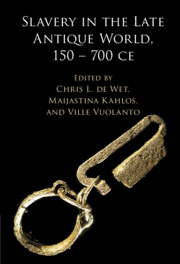Book contents
- Slavery in the Late Antique World, 150–700 CE
- Slavery in the Late Antique World, 150–700 CE
- Copyright page
- Contents
- Figures
- Tables
- Contributors
- Preface
- A Note on Abbreviations and Sources Used
- Introduction Late Antique Studies and the New Polyphony for Slave Studies
- Part I Moral and Symbolic Values of Slavery
- Part II Slavery, Cultural Discourses, and Identity
- 5 Slavery in Euphemia and the Goth
- 6 What Was Jewish about Jewish Slavery in Late Antiquity?
- 7 Divining Slavery in Late Ancient Egypt: Doulology in the Monastic Works of Paul of Tamma and Shenoute
- 8 Rural Slavery in Late Roman Gaul: Literary Genres, Theoretical Frames, and Narratives
- Part III Slavery, Social History, and the Papyrological and Epigraphical Sources
- Part IV Social and Religious Histories of Slavery on the Borders of the Empire and Beyond
- Bibliography
- Index
6 - What Was Jewish about Jewish Slavery in Late Antiquity?
from Part II - Slavery, Cultural Discourses, and Identity
Published online by Cambridge University Press: 27 January 2022
- Slavery in the Late Antique World, 150–700 CE
- Slavery in the Late Antique World, 150–700 CE
- Copyright page
- Contents
- Figures
- Tables
- Contributors
- Preface
- A Note on Abbreviations and Sources Used
- Introduction Late Antique Studies and the New Polyphony for Slave Studies
- Part I Moral and Symbolic Values of Slavery
- Part II Slavery, Cultural Discourses, and Identity
- 5 Slavery in Euphemia and the Goth
- 6 What Was Jewish about Jewish Slavery in Late Antiquity?
- 7 Divining Slavery in Late Ancient Egypt: Doulology in the Monastic Works of Paul of Tamma and Shenoute
- 8 Rural Slavery in Late Roman Gaul: Literary Genres, Theoretical Frames, and Narratives
- Part III Slavery, Social History, and the Papyrological and Epigraphical Sources
- Part IV Social and Religious Histories of Slavery on the Borders of the Empire and Beyond
- Bibliography
- Index
Summary
Just like other late antique societies, Jewish society in late antique Palestine was a slaveholding society in which slavery was a common phenomenon of daily life. Even though the proportional numbers of slaves within the population would not have reached the extent of Roman mass slavery, many similarities existed between Jewish and Roman slave practices and attitudes towards slaves. At the same time, we must ask whether Jews, who were subjugated to Roman and Byzantine Christian imperial rule and considered the Torah their most authoritative moral guide, developed different perspectives on slavery and treated slaves differently than non-Jewish Romans, whether pagan or Christian, in late antiquity. Was there something specifically Jewish about Jewish slaveholding practices in late antiquity? Did Jews, who commemorated the Exodus from Egyptian slavery in the annual Passover holiday and who were seen as a ‘servile’ people by Roman rulers, develop alternative approaches to slavery?
- Type
- Chapter
- Information
- Slavery in the Late Antique World, 150 – 700 CE , pp. 129 - 148Publisher: Cambridge University PressPrint publication year: 2022
- 1
- Cited by

